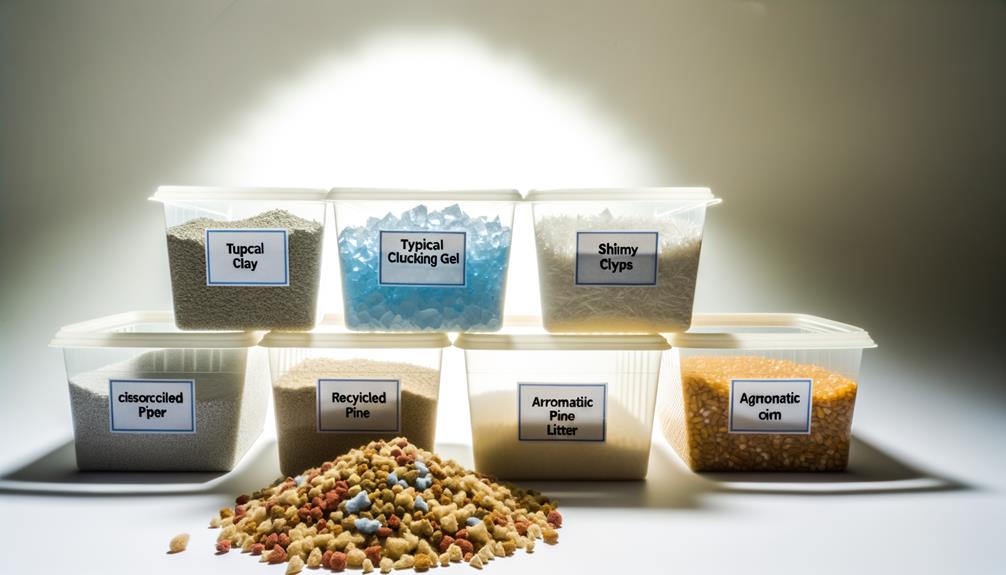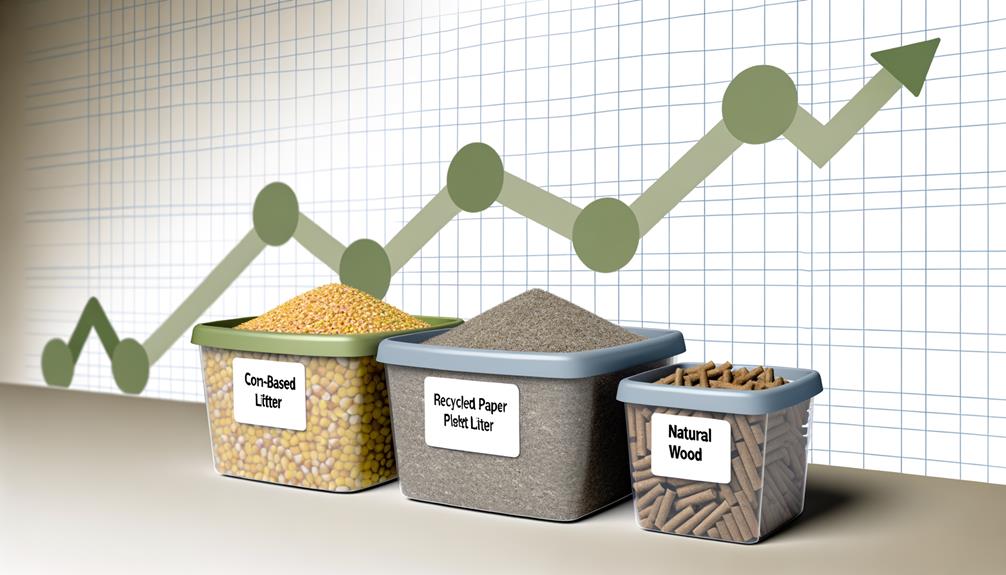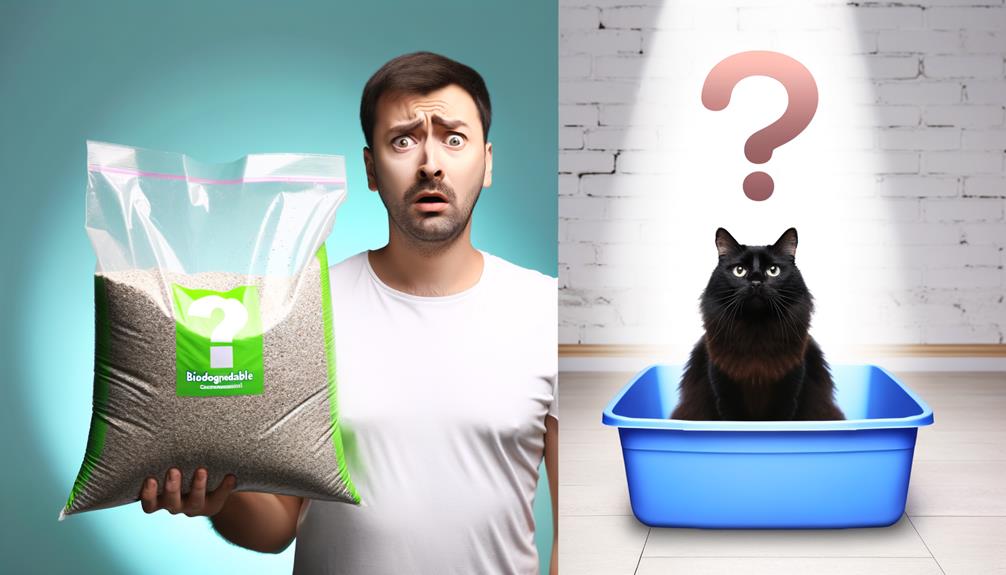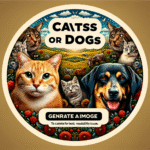As a cat owner, you've probably pondered over which type of cat litter is best. Is it clumping, crystals, or biodegradable? Each has its pros, like clumping litter's absorbency, crystal litter's hypoallergenic properties, and biodegradable litter's environmental friendliness. Yet, each also has its cons. But how do these options compare when you consider your cat's health, your home's cleanliness, and your commitment to the environment? There's a lot to contemplate, isn't there? So, why don't we unpack this puzzle together?
Key Takeaways
- The best cat litter depends on the cat's preferences, allergies, and the owner's eco-consciousness and budget.
- Clumping clay litter offers superior absorbency and odor control, but may produce dust.
- Silica gel litter is hypoallergenic and highly absorbent, but more expensive and might cause respiratory issues.
- Biodegradable litters like corn, wheat or wood shavings are environmentally friendly, dust-free, but can trigger allergies.
- The transition to a new litter type should be gradual, with the cat's behavior and possible allergies closely monitored.
Understanding Different Cat Litter Types

Navigating the cat litter aisle can be overwhelming, but understanding the different types of cat litter can simplify your decision-making process. When it comes to litter dustiness and litter tracking, what you choose matters.
Litter dustiness is a crucial factor to consider. If you've ever poured cat litter into a tray and ended up in a dust cloud, you've experienced a dusty litter. It's not just irritating for you but can also be harmful to your cat's respiratory system. Look for low-dust or dust-free options to minimize this issue.
On the other hand, litter tracking is about the mess. If you're constantly finding tiny litter granules all over your house, your cat's litter is tracking. Some litters are designed to minimize this problem, typically those with larger granules.
There are several types of cat litter you can choose from. Clay litter is a popular choice due to its ability to absorb and control odor. However, it tends to be dusty and can track easily. Silica gel litter is virtually dust-free and doesn't track as much, but it's more expensive. Biodegradable options like corn, wheat, or wood shavings are eco-friendly and can be low-dust, but they mightn't control odor as well and could track more.
Benefits of Clumping Cat Litter
You might be wondering why clumping cat litter is a popular choice among pet owners.
It's mainly due to two key advantages: superior absorbency and excellent odor control.
Let's unpack these benefits for a clearer understanding.
Clumping Litter's Superior Absorbency
One major benefit of clumping cat litter is its superior absorbency, which makes cleaning up after your feline friend a breeze. This type of litter quickly soaks up liquids, forming solid clumps that are easy to scoop out, leaving the rest of the litter clean and dry. But that's not all.
If you're dealing with litter allergies, clumping litter might be an answer. Unlike non-clumping litters, it doesn't produce as much dust, so it's less likely to trigger allergies or cause respiratory issues. Dust issues can be a real nuisance when it comes to cat litter, but with clumping litter, these problems can be significantly reduced. So, you're not just making your life easier, but also creating a healthier environment for your cat.
Odor Control With Clumping
Another significant advantage of clumping cat litter is its exceptional ability to control odors. It's a savior for your nose, absorbing and sealing away unpleasant smells before they can invade your home.
Beyond odor control, let's consider 'Litter Tracking Prevention'. Clumping litter sticks together when wet, instead of scattering, reducing those annoying trails of litter across your floors.
Lastly, 'Allergy Considerations'. You'll find that clumping litter creates less dust, making it a better choice for those who suffer from allergies. It's not completely dust-free, but it's a significant improvement over non-clumping varieties.
Drawbacks of Clumping Litter

Despite its popularity, clumping litter isn't without its drawbacks. Foremost among these are litter allergies and dust issues that can be a real headache for both you and your feline friend.
If your cat has a sensitive respiratory system or if you're prone to allergies, clumping litter may not be the best choice. The dust that clumping litter produces when poured can trigger allergic reactions. It's not just sneezing and coughing you need to worry about. In severe cases, it can cause asthma attacks or other respiratory problems. The dust particles can also stick to your cat's paws and fur, which they may ingest while grooming, leading to internal issues.
Another significant drawback is that clumping litter can cause blockages if ingested in large amounts, especially by kittens. It's designed to clump together when it comes into contact with moisture, and it will do the same in your cat's digestive system. This can lead to serious health problems, including dehydration and even potentially fatal blockages.
Furthermore, while clumping litter is typically more convenient for you, it's not as environmentally friendly as other options. Most clumping litters are made with sodium bentonite, a type of clay that's strip-mined. This process is harmful to the environment, causing habitat destruction and soil erosion.
Why Choose Crystal Cat Litter?
You might wonder why to opt for crystal cat litter.
We'll examine its benefits and compare it to the more traditional clay litter.
We'll also assess its impact on your cat's health to give you a clear understanding.
Crystal Litter Benefits
Over time, crystal cat litter has become a popular choice for many cat owners due to its unique benefits. One major advantage is its hypoallergenic nature. Unlike some other types, crystal litter allergies are far less common, offering you peace of mind for your feline friend's health. It's also highly absorbent, meaning it's efficient in controlling odors.
But there's more. Crystal litter also includes color changing indicators. Once your cat has done their business, the crystals change color to signal it's time for a clean-up. This innovative feature takes the guesswork out of maintaining your cat's litter box, helping you to keep it clean and fresh with minimal effort. These benefits make crystal cat litter a strong contender in the quest for the best cat litter.
Comparing Crystal to Clay
When comparing crystal to clay cat litter, it's clear that crystal offers superior odor control and less frequent changes, making it a smarter choice for your feline's litter box.
You'll find that litter tracking issues aren't as severe with crystal litter. Unlike clay, it doesn't stick to your cat's paws, reducing the amount of litter scattered around your home.
Moreover, the dust production comparison also plays in favor of crystal litter. While clay litter can create a dusty environment when your cat digs or when you're scooping, crystal litter significantly reduces dust production. This contributes to a cleaner and more pleasant home environment.
Health Impact on Cats
Beyond its practical benefits, crystal cat litter also has significant health advantages for your furry friend. If your cat suffers from litter allergies, switching to crystal litter could be a game-changer. It's hypoallergenic, meaning it's less likely to irritate your kitty's sensitive skin or respiratory system.
Dust concerns are another factor to consider. Unlike traditional clay litters that can create a dusty mess, crystal litters are virtually dust-free. This not only keeps your home cleaner but also protects your cat from inhaling harmful dust particles.
Disadvantages of Crystal Litter
While crystal cat litter has its merits, it's important to also consider its drawbacks. One notable downside is the issue of crystal dust. Although manufacturers often claim their products are dust-free, you'll find this isn't always the case when you pour the litter into the tray. You might notice a fine powder rising, which can be harmful if inhaled by either you or your cat. This crystal dust issue is a serious concern, as it can lead to respiratory problems in the long run.
Additionally, crystal litter doesn't come with a color variety. You might think, why does color matter? It's not about aesthetic appeal, but about your ability to detect changes in your cat's urine. With traditional clay or clumping litter, you can notice if the urine is darker, indicating possible health issues. Unfortunately, crystal litters, with their shiny, translucent properties, don't offer this advantage. The color variety significance in cat litter is crucial for keeping an eye on your pet's health.
Moreover, crystal litter isn't as comfortable under your cat's paws as other types. Some cats may even refuse to use it altogether, making the litter box a point of contention. Finally, while crystal litter is known for its high absorbency, it's also more expensive than most other types. This can add up over time, especially if you have multiple cats.
The Rise of Biodegradable Cat Litter

You've probably heard about biodegradable cat litter, right?
Well, it's time we talk about its benefits, some of the popular brands on the market, and how it stacks up against traditional litters.
This could be the game-changer you've been looking for.
Benefits of Biodegradable Litter
In recent years, a significant number of cat owners have been making the switch to biodegradable litter due to its numerous benefits.
It's not hard to see why when you consider the sustainable sourcing practices involved in biodegradable litter manufacturing. Unlike traditional clay litters, biodegradable options are often made from renewable resources like corn, wheat, or recycled paper.
They're not only kinder to the environment, but they can also be composted or flushed, making disposal easier for you. Additionally, they're typically dust-free and non-toxic, which is better for your cat's respiratory health.
Popular Biodegradable Litter Brands
Let's dive into some of the top biodegradable cat litter brands that have been gaining popularity among discerning cat owners. Sustainably Yours and World's Best Cat Litter are two standout brands. They're lauded not only for their effective odor control and easy clumping but also for their environmentally friendly practices.
Sustainably Yours utilizes biodegradable packaging options that lessen waste while World's Best Cat Litter is renowned for its compostable litter, allowing you to compost used litter in an eco-friendly manner. Both brands are also known for their dust-free formulations, crucial to keeping your cat healthy. These companies are leading the way, showing that it's possible to care for your cat and the environment simultaneously.
Comparing Biodegradable and Traditional Litters
While traditional cat litter has long dominated the market, biodegradable versions are steadily gaining ground, offering both environmental benefits and superior performance. You're probably wondering how this is possible, right? Well, one major advantage of biodegradable litter is its recyclability. Recycling biodegradable litter can reduce landfill waste and even be converted into compost, thereby contributing to a more sustainable environment.
Moreover, composting cat waste, which is specifically possible with biodegradable litter, returns essential nutrients to the soil. It's a win-win situation for you and Mother Earth. However, it's crucial to compost properly to prevent the spread of harmful bacteria. So, if you're environmentally-conscious and want to provide a cleaner, fresher litter for your feline, consider making the switch to biodegradable options.
Concerns With Biodegradable Litter

Even though biodegradable cat litter has its perks, you might have some concerns about its use. One of your worries could be its safety. While biodegradable litter is often marketed as a healthier choice for your pet and the environment, it's important to remember that not all biodegradable litters are created equal.
When it comes to Biodegradable Litter Safety, some varieties might contain fragrances or other additives that could trigger allergies or asthma in sensitive cats. In addition, some types of biodegradable litter, such as those made from wheat or corn, can be harmful if your cat ingests them in large amounts. Always research the ingredients and avoid litters that contain potentially harmful substances.
Another concern you might have is about Biodegradable Litter Production. You might be wondering how eco-friendly the production process really is. The truth is, although biodegradable litter is designed to break down naturally in the environment, the manufacturing process might still have a significant carbon footprint. The production of corn and wheat-based litters, for instance, often involves the use of fertilizers and pesticides, which can harm the environment. Moreover, the process of turning these materials into litter can also use a lot of energy and contribute to pollution.
How to Transition to a New Litter
Switching your cat to a new litter isn't as daunting as it might seem, but it does require a gradual, careful approach to ensure your feline friend adjusts comfortably. The key lies in understanding your cat's preferences and behaviors, while also watching out for any signs of litter allergies.
Begin by introducing the new litter in a separate box, placed next to the existing one. This way, your cat has a choice and it won't feel forced into using the unfamiliar litter. It's essential to monitor your cat's acceptance of the new product during this phase.
If your cat shows interest in the new litter, start mixing it with the old one in the original box. Begin with a small amount and increase it gradually over a period of one to two weeks. This slow transition will help your cat adjust to the new texture and smell without causing stress or confusion.
However, you should be observant for signs of litter allergies. Symptoms can include sneezing, itching, watery eyes, or skin rashes. If you notice any of these, it's best to consult with your vet before proceeding further.
It's worth noting that not all changes are successful. Your cat may outright reject the new litter. In such a case, don't force the transition. Instead, try another type of litter. Remember, the ultimate goal is your cat's comfort and well-being. Patience, observation, and understanding will go a long way in making the transition smooth and stress-free for your beloved pet.
Cost Comparison: Cat Litter Types

After you've found a litter that suits your cat's preferences and doesn't cause allergies, it's time to consider the financial aspect of your choice. The cost of cat litter can vary greatly, with factors such as litter longevity and litter accessibility playing significant roles.
Litter longevity refers to how long a type of litter lasts before you need to replace it. For example, clay litter might seem cheaper initially, but it often needs replacing more frequently than other types, like silica gel or recycled paper pellets. Therefore, you might end up spending more in the long run with clay litter due to its shorter longevity.
On the other hand, litter accessibility means how easily you can find and purchase a specific type of cat litter. Specialty litters like those made from recycled materials or plant-based products might be more expensive and harder to find than traditional clay or silica options. If you choose a less common litter type, you might find yourself spending extra time and money to locate it.
When comparing costs, consider both upfront and long-term expenses. Include in your calculations the frequency of litter changes and the availability of the litter type. You may find that an initially more expensive litter lasts longer and is actually more cost-effective over time.
Lastly, remember that while cost is an important factor, it shouldn't be the only one. Your cat's health and comfort should always come first. So, even if it's a bit pricier, go for the litter that your furry friend prefers and tolerates well. That's the best investment you can make.
Odor Control Capabilities Compared
One of the most crucial aspects you'll want to consider when choosing cat litter is its ability to control odors. Different litters have varying strengths when it comes to odor control, and it's essential to find one that suits your needs.
Firstly, let's discuss litter longevity. This refers to how long a particular litter can effectively control odors before it needs to be replaced. Some litters, like clumping clay, are excellent at absorbing urine and preventing the spread of odor. However, they can become less effective over time, so you'll need to replace them more frequently. On the other hand, silica gel crystals have a more extended period of odor control, meaning less frequent litter changes for you.
Now, the question of scented vs. unscented. You might think that scented litter would be the clear winner in odor control, but that's not always the case. While scented litter can mask odors, some cats might find the fragrance too overpowering. Additionally, some scented litters only cover up the smell, without actually eliminating it. Unscented litters, however, focus on trapping and neutralizing odors without the added fragrance. They might be a better choice if your cat is sensitive to strong smells or if you prefer a more natural approach.
Cat Litter and Environmental Impact

While you're considering odor control, don't forget to factor in the environmental impact of your chosen cat litter. It's not just about what works best for you and your feline friend, but also what's best for our planet. Consider cat litter that utilizes sustainable sourcing and practices responsible litter disposal.
Sustainable sourcing is all about obtaining materials in a way that respects the environment and conserves natural resources. Some cat litters are made from recycled newspapers or plant-based materials like wheat or corn. These litters aren't only biodegradable but also require less energy to produce than clay-based litters. You're not only choosing a product that's effective, but one that's also helping to reduce your carbon footprint.
Now, let's talk about litter disposal. Traditional clay-based litters often end up in landfills, where they can take hundreds of years to break down. On the other hand, biodegradable litters can be composted, reducing waste. However, remember that while these litters are better for the environment, they should never be flushed down the toilet. Cat feces can contain a parasite harmful to marine life, so always dispose of it in the trash.
Choosing a cat litter with sustainable sourcing and environmentally friendly disposal options doesn't mean compromising on quality. Many of these options are excellent at odor control and clumping. So, you're not only making a decision that's good for the environment, but you're also ensuring a clean and fresh-smelling home. It's a win-win situation.
Finding Your Cat's Preferred Litter
Often, finding the perfect litter involves understanding your cat's preferences, as they can be surprisingly particular about their litter's texture and scent. Just like humans, cats can be finicky, and what one cat loves, another might utterly despise. To find your furry friend's preferred litter, you'll need to pay attention to their behavior and possibly try out a few different options.
Some cats might've litter allergies, which could manifest as frequent sneezing or paw licking. If you notice these signs, it's a good idea to switch to a hypoallergenic litter. These litters are usually made from natural materials like corn, wheat, or recycled paper and don't have the dust or artificial fragrances that can trigger allergies.
The litter box design can also influence your cat's comfort level and willingness to use it. High-sided boxes can be difficult for older or smaller cats to get into, and covered boxes might feel too enclosed for some. Ideally, the litter box should be large enough for your cat to turn around in and easy to get in and out of.
Frequently Asked Questions
Can Cat Litter Cause Health Issues for My Pet?
Yes, cat litter can potentially cause health issues for your pet. Litter allergies and dust inhalation can lead to respiratory problems. It's crucial to choose a low-dust, hypoallergenic litter to keep your kitty healthy.
How Often Should I Replace My Cats Litter?
You should replace your cat's litter once a week. Different litter types offer varying levels of odor control, so you might need to adjust based on the litter you're using and your cat's habits.
Are There Cat Litters That Can Be Flushed Down the Toilet?
Yes, there are flushable cat litters, but they come with risks like potential pipe blockages. You might want to consider eco-friendly alternatives that aren't flushable, but still minimize environmental impact.
How Can I Properly Dispose of Used Cat Litter?
To properly dispose of used cat litter, bag it securely to maintain litter odor control. Check recycling possibilities in your area for the bag. Don't flush it as it can clog pipes and harm marine life.
What Are Some Signs My Cat Is Not Comfortable With Its Litter?
If your cat's avoiding the litter box or showing signs of allergic reactions, like sneezing or itching, it may not be comfortable with its litter. These can indicate your cat's litter preferences aren't being met.
Conclusion
In conclusion, choosing the right cat litter isn't a one-size-fits-all situation. Your cat's preferences, health, and the environment all play a role.
Clumping litter offers excellent absorbency and odor control, but crystal litter has hypoallergenic properties. Biodegradable options are eco-friendly but can be pricey.
Weigh these factors carefully and remember, your cat's comfort is paramount. Finding the perfect balance can lead to a happier, healthier feline friend and a fresher home.







